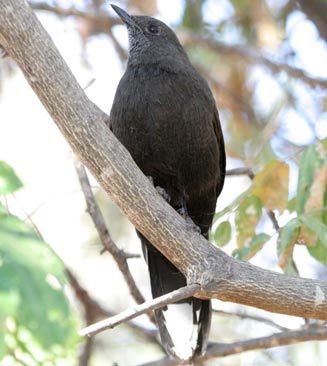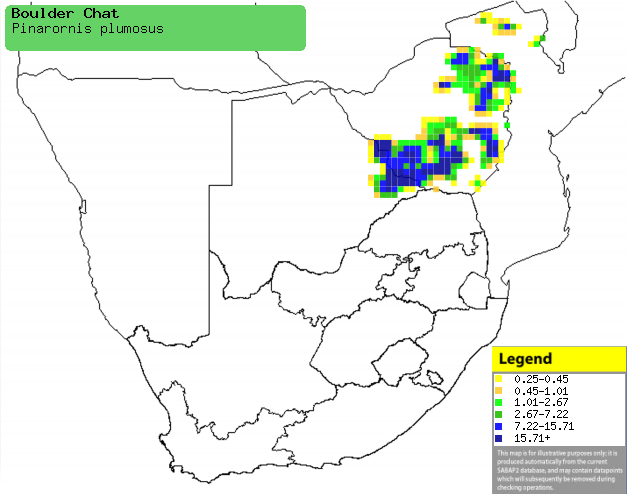|
Pinarornis plumosus (Boulder chat)
Swartberglyster [Afrikaans]; Steenspringer [Dutch]; Rochassier des
éboulis [French]; Steindroßling [German]; Chasco-das-rochas [Portuguese]
Life
> Eukaryotes >
Opisthokonta
> Metazoa (animals) >
Bilateria >
Deuterostomia > Chordata >
Craniata > Vertebrata (vertebrates) > Gnathostomata (jawed
vertebrates) > Teleostomi (teleost fish) > Osteichthyes (bony fish) > Class:
Sarcopterygii (lobe-finned
fish) > Stegocephalia (terrestrial
vertebrates) > Tetrapoda
(four-legged vertebrates) > Reptiliomorpha > Amniota >
Reptilia (reptiles) >
Romeriida > Diapsida > Archosauromorpha > Archosauria >
Dinosauria
(dinosaurs) > Saurischia > Theropoda (bipedal predatory dinosaurs) >
Coelurosauria > Maniraptora > Aves
(birds) > Order: Passeriformes
> Family: Muscicapidae
 |
|
|
Boulder chat, Mmabolela Farm, Limpopo Province,
South Africa. [photo
Gareth H ©] |
|
Distribution and habitat
Near endemic to southern Africa, occurring from eastern
Botswana to Zimbabwe and northern Mozambique, marginally extending into Angola
and Zambia. It mainly occupies well-wooded granite outcrops, batholiths and
hills, where there are scattered granite boulders around the top and scree
slopes at the base. If in area becomes to densely vegetated it often deserts the
place permanently.
|
 |
|
Distribution of Boulder chat in southern Africa,
based on statistical smoothing of the records from first SA Bird Atlas
Project (©
Animal Demography unit, University of
Cape Town; smoothing by Birgit Erni and Francesca Little). Colours range
from dark blue (most common) through to yellow (least common). |
Brood parasites
It has been recorded as host of the
Red-chested cuckoo.
Food
It mainly eats arthropods and small lizards, doing some of
its foraging on the ground beneath boulders and rocks, occasionally in leaf
litter. It may hawk insects aerially from a perch on a rock, and it also
clumsily hovers next to trees, gleaning food from their leaves and branches.
Breeding
- The nest is cup built of bark, leaves and twigs, set into a foundation of
earth clods and lined with leaf petioles. It is typically placed underneath
a boulder, in a cavity between two rocks or next to a log.
- Egg-laying season is from September-January, peaking from
October-November.
- It lays 2-4 eggs, which are incubated for about 13-14 days.
- The chicks leave the nest at about 16-20 days old, before they can fly,
after which they hide under boulders until they fledge. They may still
remain dependent on their parents until the following breeding season
Threats
Not threatened, although it deserts any areas which become
infested with the alien Cherry-pie (Lantana camara), which may cause
problems for it in the future.
References
-
Hockey PAR, Dean WRJ and Ryan PG 2005. Roberts
- Birds of southern Africa, VIIth ed. The Trustees of the John Voelcker
Bird Book Fund, Cape Town.
|
